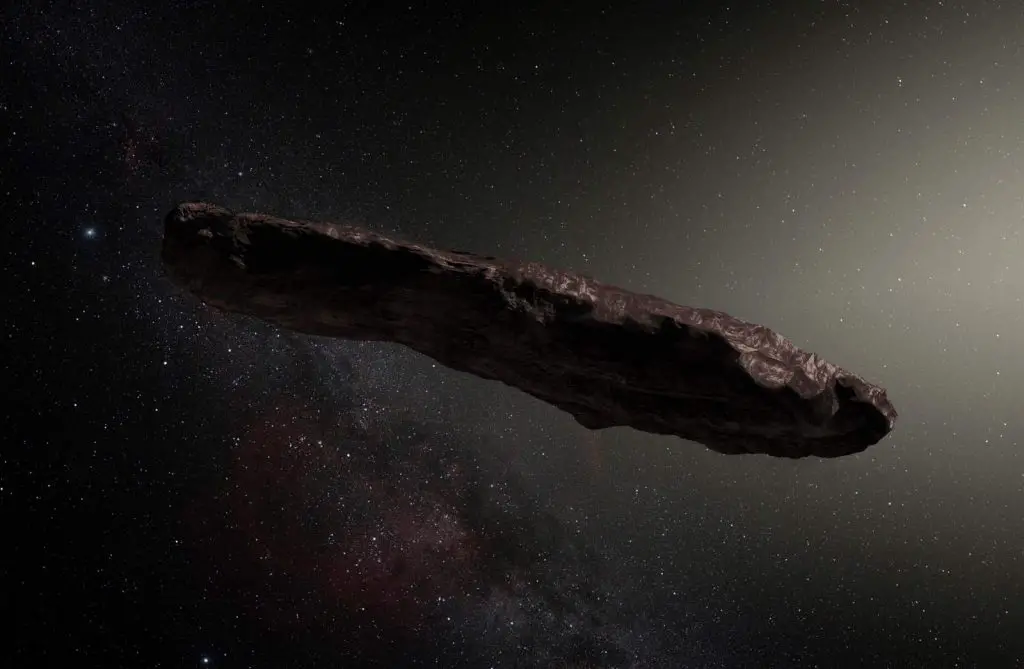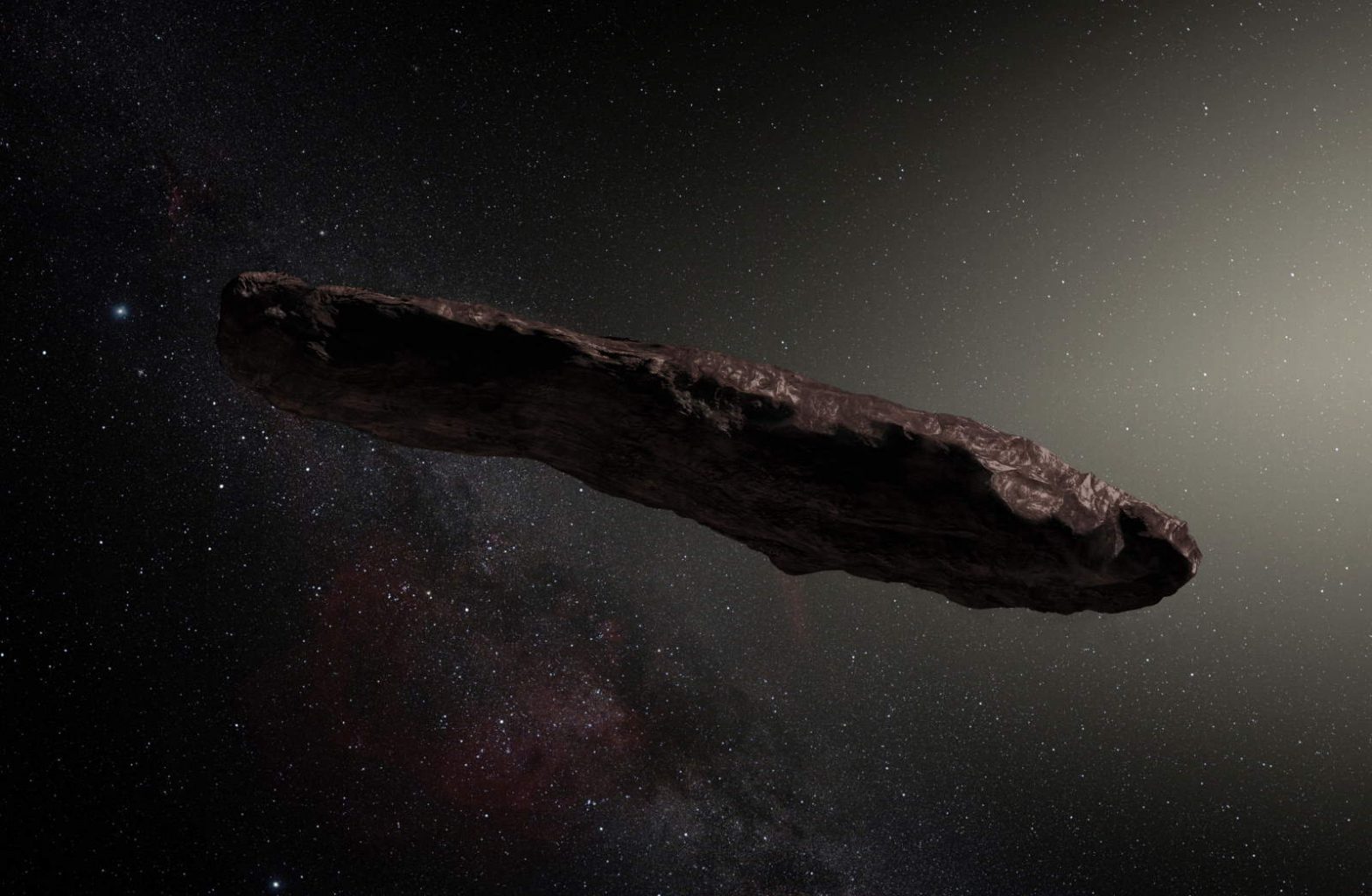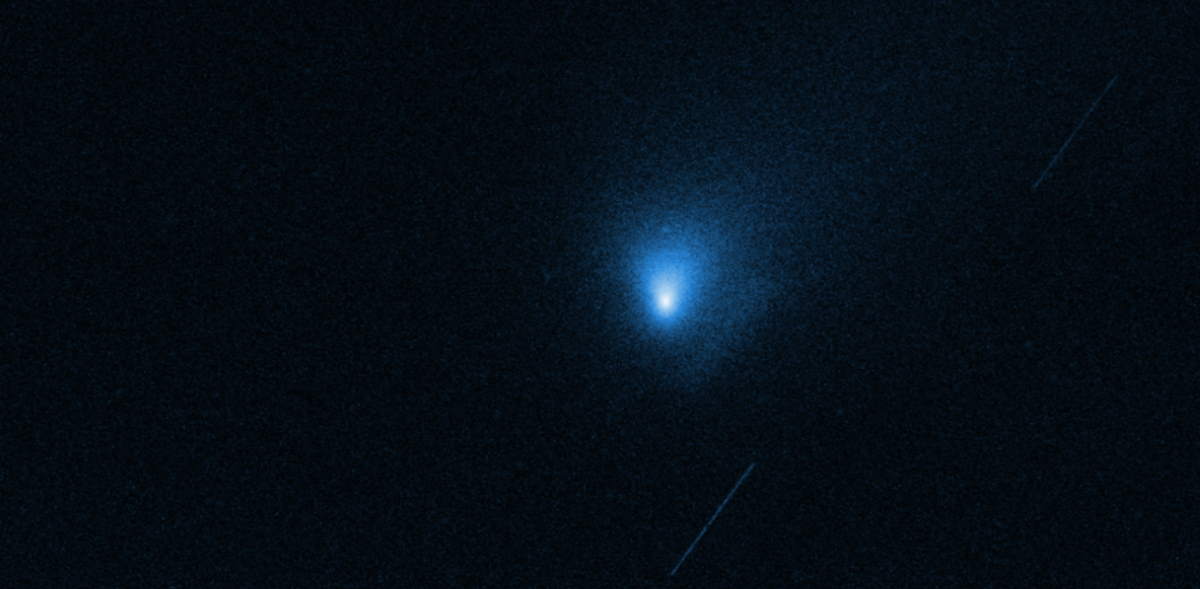‘Oumuamua, the first known interstellar object to visit our solar system was first detected on October 19, 2017, by the University of Hawaii’s Pan-STARRS1 telescope.
Today’s (October 19) story of what happened this day in Science, Technology, Astronomy, and Space Exploration history.
‘Oumuamua
‘Oumuamua, formally designated 1I/2017 U1 is the first interstellar object detected passing through the Solar System. It was detected on October 19, 2017, by the Canadian physicist and astronomer Robert Weryk using the Pan-STARRS telescope at Haleakalā Observatory, Hawaii.
When discovered, ‘Oumuamua had already passed (about 40 days before) its closest point to the Sun (on 9 September).
When detected, it was about 33 million kilometers (21 million miles, about 1/5 of the distance between Earth and Sun, AU) from Earth (about 85 times as far away as the Moon), and already heading away from the Sun.
‘Oumuamua is a small cigar-shaped object estimated to be between 100 and 1,000 meters (300 and 3,000 feet) long, with its width and thickness both estimated to range between 35 and 167 meters (115 and 548 feet). That aspect ratio is greater than that of any asteroid or comet observed in our solar system to date.
How ‘Oumuamua Got its Name
It was officially named 1I/2017 U1 by the International Astronomical Union (IAU), which is responsible for granting official names to bodies in the solar system and beyond. In addition to the technical name, the Pan-STARRS team that discovered the object dubbed it ‘Oumuamua, which is Hawaiian for “a messenger from afar arriving first.” (from ‘ou “reach out for”, and mua, reduplicated for emphasis “first, in advance of”)

‘Oumuamua gets an unexpected speed boost
In June 2018, using observations from NASA’s Hubble Space Telescope and ground-based observatories, an international team of scientists confirmed that ‘Oumuamua got an unexpected boost in speed and shift in trajectory as it passed through the inner solar system.
By analyzing the trajectory of the interstellar visitor, scientists found that the speed boost was consistent with the behavior of a comet.
So, this boost was likely caused by jets of gaseous material expelled from its surface.
Comets normally eject large amounts of dust and gas when warmed by the Sun. But there were no visible signs of outgassing from ‘Oumuamua. Scientists estimate that the outgassing may have produced a very small amount of dust particles, enough to give the object a little kick in speed, but not enough to be detected.
How do scientists know that ‘Oumuamua has an interstellar origin?
Based on observations spanning 80 days, ‘Oumuamua’s orbital eccentricity was 1.20, the highest ever observed until 2I/Borisov, the next interstellar object discovered in our solar system was discovered in August 2019.
An eccentricity exceeding 1.0 means an object exceeds the Sun’s escape velocity, is not bound to the Solar System, and may escape to interstellar space.
While an eccentricity slightly above 1.0 can be obtained by encounters with planets, as happened with the previous record holder, C/1980 E1 (a non-periodic comet discovered by the American astronomer Edward L. G. Bowell on February 11, 1980), ‘Oumuamua’s eccentricity is so high that it could not have been obtained through an encounter with any of the planets in the Solar System.
Even undiscovered planets in the Solar System, if any should exist, could not account for ‘Oumuamua’s trajectory nor boost its speed to the observed value. For these reasons, it can only be of interstellar origin.
So, Because of its high speed (196,000 mph, 315,431 km/h, or 87.3 kilometers per second) and its trajectory around the Sun, by mid-November 2017, astronomers were certain that the ‘Oumuamua was an interstellar object.
10 ‘Oumuamua facts
1. It has an interstellar origin
Because of its high speed (196,000 mph, or 87.3 kilometers per second) and the trajectory it followed as it whipped around the Sun, scientists are confident ‘Oumuamua originated beyond our solar system. Comets and asteroids from within our solar system move at a slower speed, typically an average of 12 miles per second (19 kilometers per second).
The object flew by Earth so fast its speed couldn’t be due to the influence of the Sun’s gravity alone, so it must have approached the solar system at an already high speed and not interacted with any other planets.
2. We are not sure where it came from
‘Oumuamua entered our solar system from the rough direction of the constellation Lyra, but it’s impossible to tell where it originally came from. Thousands of years ago, when it started to wander from its parent planetary system, the stars were in a different position so it’s impossible to pinpoint the object’s point of origin.
It could even have been wandering the galaxy for billions of years and thus may have originated from an entirely different part of the galaxy.
3. It won’t come back
‘Oumuamua is headed back out of our solar system and won’t be coming back. It’s rapidly headed in the direction of the constellation Pegasus and crossed the orbit of Neptune in about four years (as of 2022, it crossed the orbit of Neptune). It covers one light-year’s distance in about 11,000 years.
For comparison, it took 12 years for Voyager 2 to reach Neptune.
4. We don’t really know what it looks like
We’ve only seen it as a speck of light through a telescope (it is far away and less than half a mile in length), but its unique rotation leads scientists to believe that it’s elongated like a cigar, about 10 times longer than it is wide.
Artists’ concepts are the best guesses at what it might look like.
5. We can’t see ‘Oumuamua anymore
It’s so far away that our telescopes are not strong enough. After January 2018, ‘Oumuamua was no longer visible to telescopes, even to space telescopes.
6. It’s tumbling
Its brightness had unusual variations, so scientists think that the object is tumbling (rotating on more than one axis).
7. We don’t know what it’s made of
Comets in our solar system kick off lots of dust and gas when they get close to the Sun, but ‘Oumuamua did not, which led observers to consider defining it as an asteroid.
But, that speed boost in 2018 could mean that the ‘Oumuamua could be giving off gases that are harder to see than dust, but it’s impossible to be certain at this point.
8. It might not be the first known interstellar object
‘Oumuamua is possibly the second interstellar object known; the first being a purported interstellar meteor CNEOS 2014-01-08 that impacted Earth in 2014, detected on 8 January 2014 near the northeast coast of Papua New Guinea.
9. It is too fast
‘Oumuamua moves too fast for our chemical rockets to catch up with it now without a gravitational assist from planets. But despite that enormous speed (196,000 mph, 315,431 km/h, or 87.3 kilometers per second), it would take ‘Oumuamua many years to leave the solar system entirely. Space is big!
10. We’ll find more ‘Oumuamuas, “messengers from afar”
The more we observe the skies, the more interstellar objects we are sure to find.
Sources
- ‘Oumuamua on the NASA Solar System Exploration website
- “Our Solar System’s First Known Interstellar Object Gets Unexpected Speed Boost” on the NASA website
- “10 Things: Mysterious ‘Oumuamua” on the NASA Solar System Exploration website
- Moon Landings: All-Time List [1966-2025] - February 2, 2025
- What Is Max-Q and Why Is It Important During Rocket Launches? - January 16, 2025
- Top 10 Tallest Rockets Ever Launched [2025 Update] - January 16, 2025

